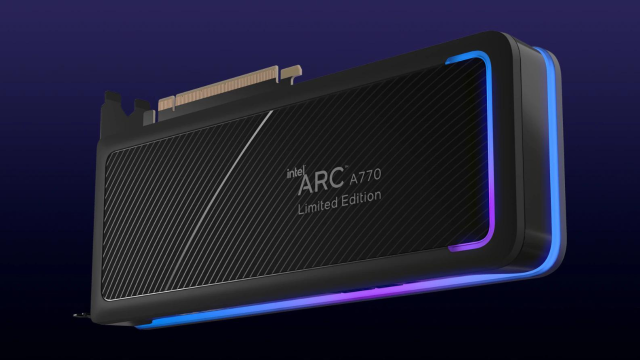The Intel Arc series of GPUs are now available for purchase in Australia, meaning you can have a dedicated Intel graphics card inside your custom-built PC, however, there’s still a lot of confusion surrounding Intel’s run at AMD and Nvidia, the two kings of the GPU market.
Well, player three has entered the market and now that there’s a third GPU option, so let’s see how it stacks up against the competition.
What is Intel Arc?
Intel Arc is the name of Intel’s dedicated GPU range. Previously, Intel was a champion at creating integrated graphics such as the Intel Iris Xe, which would pair with its CPUs (namely the Intel Core series, such as the Core i5, i7 and i9).
But in 2022, Intel has released a run of graphics components to take AMD and Nvidia on. Nvidia is the company behind the current market leader, the RTX series (formerly the GTX series), and AMD is behind the Radeon series.
Like with Nvidia and AMD, the Intel Arc series relies on two sub-markets in the PC world: the laptop market and the desktop market. Laptop markets get smaller, mobile versions of the GPUs, whereas desktop computers typically get the bulkier, larger Intel Arc cards (which you can see in the image at the top of this page).
So far, we’ve reviewed only one computer with Intel Arc graphics: Intel’s own NUC 12 Enthusiast. We were impressed by the graphics performance, though readers of that review should keep in mind that it uses an A770M GPU, which is the smaller, integrated version (characterised by the M).
What GPUs are in the Intel Arc series and how much do they cost?
Right now, the Arc series only includes a small assortment of GPUs, split across three performance categories. As it currently stands, only two cards are available in Australia, plus mobile versions. Here’s a full list of the Arc series cards, though if we’ve missed one, let us know.
Arc 7
- A730M: mobile GPU, included in smaller computers
- A750 8GB: $549
- A770 8GB: not yet available in Australia
- A770 16GB: $699
- A770M: mobile GPU, included in smaller computers
Arc 5
- A550M: mobile GPU, included in smaller computers
- A580: not yet available in Australia
Arc 3
- A310: not yet available in Australia
- A350M: mobile GPU, included in smaller computers
- A370M: mobile GPU, included in smaller computers
- A380: not yet available in Australia
The naming convention follows the same rules as Intel’s Core series: the bigger the number, the more powerful the unit. Additionally, the ‘M’ letter in the name indicates a discrete, integrated version, which are built for smaller computers such as laptops. More cards are planned.
It should also be said that not all the cards listed above are available in Australia and some of the mobile GPUs listed above may become available in upcoming laptops and mini PCs.
Is Intel Arc better than RTX?
Early benchmarks for the Intel Arc A370M were grim, but things aren’t as bad as they may seem. According to Intel’s own benchmarking, the A750 appeared to perform 3 per cent better than the RTX 3060 at 1080p and 5 per cent better at 1440p. Intel has also given us some performance indicators for their discrete mobile GPUs.
This holds up with our own experience with the Intel Arc A770M in the Intel NUC 12 Enthusiast. The card appeared to perform almost on par with my RTX 3060 GPU, and may have been able to hold up against the RTX card if the NUC 12 didn’t run on a discrete card.
YouTube channel Testing Games also did a terrific comparison video between the Arc A770 16GB and the RTX 3060 12GB. The video below tests both cards on Forza Horizon 5, Marvel’s Spider-Man, CS:GO, Cyberpunk 2077, Horizon Zero Dawn, Red Dead Redemption 2, Microsoft Flight Simulator, Hitman 3, Dying Light 2 and The Witcher 3. Yup, it appears that the Arc came out on top in most of these games.
That being said, the cost adds another layer of complexity. In Australia, The Intel Arc A770 16GB sells for $699, while the RTX 3060 starts at $579 (and is often on sale, having come out in February 2021). Is the slightly greater performance worth the ~$100 extra money?
As it currently stands, although the RTX 3060 is a terrific card to compare against and a brilliant cost-to-performance unit, that’s not the end of the discussion. At the moment, Intel doesn’t have GPUs to rival the RTX 3070, 3080 or 3090, much less their Ti variants or the newly released (and incredibly powerful) RTX 40 series.
More cards are on the way, but we’ll have to wait and see.
We know some people are curious to know the answer to the following question…
Does Intel Arc have RGB?
Yes, Intel Arc A770 limited edition cards come with RGB lights. Pretty lights are super important, we know.
Is Intel Arc good for gaming?
As outlined above, the Intel Arc series is definitely worth considering, especially if you can get one on discount. It might be an attractive prospect to have an entirely Intel PC, powered by an Intel CPU and GPU, but be aware that this may be pricier than one running on an RTX GPU and AMD CPU.
In testing, the Intel Arc A770 16GB definitely makes for a terrific RTX 3060 12GB alternative, but it’s all about shopping within your budget.
If you’d like some pointers on building your gaming PC, we’ve got a guide on that here. If you’d like some help picking the right CPU and GPU, here’s an explainer.

Leave a Reply